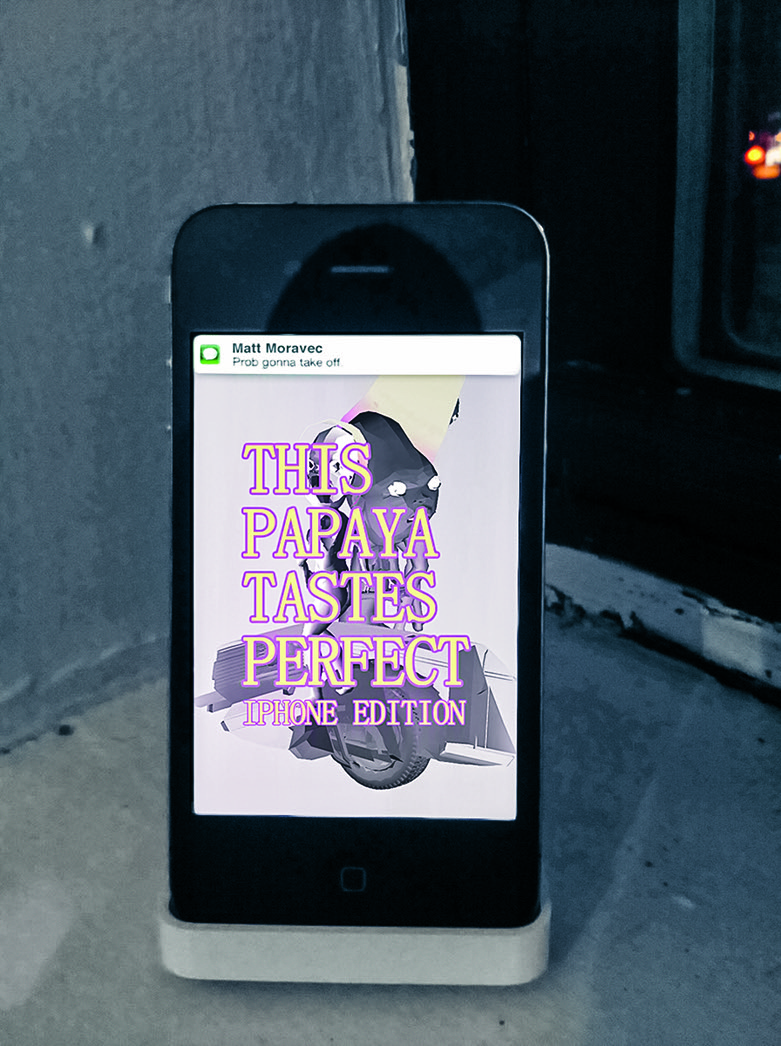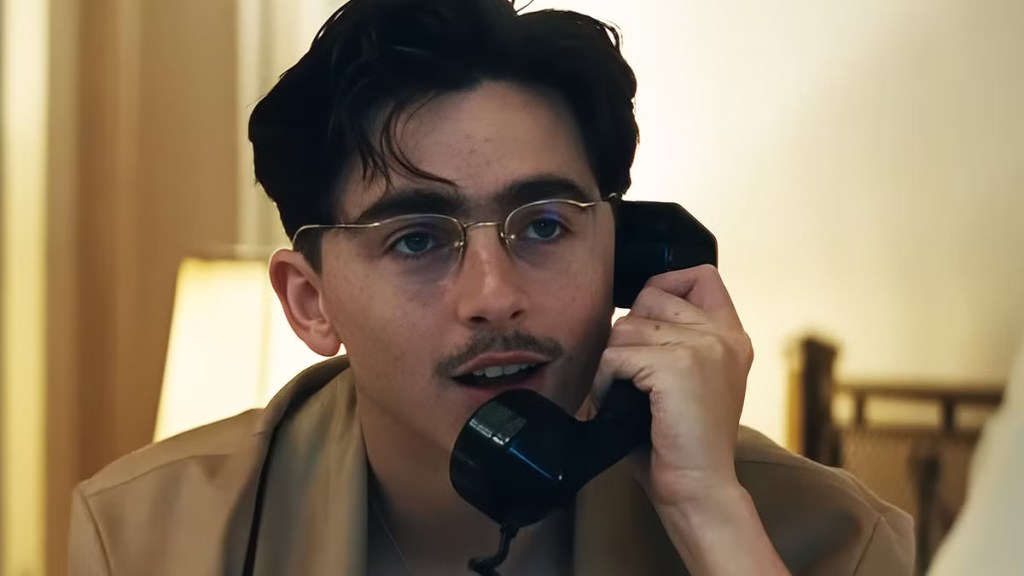This story originally appeared in GARAGE Magazine No. 11. GARAGE is a print and digital universe spanning the worlds of art, fashion, design, and culture. Our launch on VICE.com is coming soon, but until then, we’re publishing some of our old favorites, plus original stories, essays, videos, and more to give you a taste of what’s to come. Read our editor’s letter to learn more.
Ian Cheng was born in 1984 in Los Angeles. Now based in New York City, he creates virtual ecosystems he calls “simulations.” The simulations are unscripted: they function like video games that play themselves, and Cheng doesn’t know exactly how they will turn out. Each is an examination of the dynamics of human behavior, an interrogation of narrative, and an exploration of rationality and motive.
Videos by VICE
After shows at the Migros Museum in Zürich, the Smithsonian’s Hirschhorn in Washington, D.C., Pilar Corrias in London, and an installation in the Whitney Museum’s recent exhibition Dreamlands: Immersive Cinema and Art, 1905-2016, Cheng currently has on view his first U.S. museum solo presentation at MoMA PS1, entitled Emissaries, through September 25.
Exclusively for GARAGE, Cheng and Haley Mellin discuss the connection between mind and body, the effects of software on culture, and the tension between deterministic narrative and abysmal base reality.
(This introduction was revised to update the artist’s exhibition history.)
Haley Mellin: I just played the digital commission you did for the Serpentine and loved it. What brought you to cognitive science?
Ian Cheng: It was a gut feeling. I’ve always been interested in how human behavior is shaped. What is Mom thinking? What is Dad thinking? What is the cat thinking? What is their misunderstanding? What is my role between them? Things an only child thinks about. Cognitive science seemed to offer a tool set. At the time, at UC Berkeley, that was a combination of neuroscience, linguistics, computer science, and psychology, with an aim of developing a general understanding of cognition that could inform approaches to artificial intelligence.
HM: What was happening with artificial intelligence in the mid-2000s?
IC: At the time, artificial intelligence was in the dark ages. Most research was based on a kind of objectivity fallacy—the perspective that to make a computer intelligent you had to feed it a million facts—like creating a Jeopardy champion. You soon realize that a computer with a million facts quickly exhausts itself. You ask it a question like, “What do you see?” It has no idea. The current paradigm of artificial intelligence is closer to nature. It begins from a position of subjective stupidity—you endow a computer with the ability to sense and develop patterns from its senses. Humans act as its trainer. Like the way a small child or dog learns. Once an AI can learn, regardless of what it learns, it can develop a subjective understanding of the world from the bottom up, rather than from the top down. It can have agency.
HM: What was it that brought you into working with moving digital images?
IC: After Berkeley, I worked at Industrial Light & Magic, George Lucas‘s postproduction visual-effects studio. It was exciting, though, over time, I started to feel like one cog in a very, very big machine. There were hundreds of artisans and technicians working on Optimus Prime punching a skyscraper.
HM: The visual effects in those films are a fascinating force of collaboration. What happened after?
IC: I then went to grad school at Columbia’s MFA program. My peers were very talented and prolific. But I felt lost. I couldn’t bring myself to do anything. I felt art isn’t worth doing unless I can find some kind of leverage, some technology that could render the familiar into something alien. When you use a technology that has not been over-exhausted by other people, you have a stake in defining the language, the compositional principles, and a perspective toward that technology. I felt that I needed to do that, in order to feel like I wasn’t just polishing territory that many other artists have explored already. I have a constant curiosity for technologies in the loosest sense, whether an actual tool or a soft thing, like a perspective. This leveraging has been an operating principle I have had as an artist since the beginning.
HM: I saw your work first in 2012, at West Street, the apartment gallery that Alex Gartenfeld and Matt Moravec created in New York. The piece was an animation on an iPhone, which I think was placed near a window, with the Hudson River beyond it. The figure in the video was stripped of detail—just essentials—which came across to me as both primitive and advanced.
IC: The video you’re talking about is called This Papaya Tastes Perfect. It looks like an animation and it is animated, in fact, but it was done using motion capture—a process in which you place markers on a real performer’s body, so their movements can be translated onto a digital avatar. Three-dimensional animation has a reputation for being smooth, frictionless, plastic. But I wanted to see if something as artificial as 3D animation could capture human behavior that had the friction, or visceralness, that we find in life itself. This desire to get closer to nature and aliveness led to making what I call “simulations”—I think of them as video games that play themselves. They are open-ended software systems that simulate an ecology. It’s a form that can contain an ever-evolving relationship between agents and environment.

HM: Your earlier simulations were like chaotic systems. But the recent ones have an element of narrative in them.
IC: I found myself thinking about how you and I are creatures of narrative. We eat and breathe narrative. I wanted to use narrative—which I see as a deterministic, scripted force—to counterbalance the entropy and chaos in the simulations. I begin with open-ended ecosystems, which contain various agents with A.I.s that are very reactive to the environment. Then I introduce one agent who has a very different intelligence – a set of narrative goals that it doggedly tries to achieve. It’s like giving an actor a script and telling her she has to get through her lines no matter what obstacles get in her way. It’s like Shakespeare in the Park, but it’s a really disturbing, chaotic park, where everything’s going wrong, but the agent still tries.
HM: I like that your content is unpretentious and direct. You’re working with sculpting the soft material of human behavior.
IC: I feel that having a narrative script, or having a life script, is an incredibly useful tool for orienting oneself, especially in times of uncertainty. It allows you at least to give yourself a direction, and a sense of place within the timeline of the imagined script. It is a self-made fiction, but it gives you courage. In two recent simulations, Emissary in the Squat of Gods and Emissary Forks at Perfection, I’ve started to program a character that has an orienting script in spite of all the chaos around him or her. What you see as a viewer is a battle between an open-ended ecological system that is amoral—there is no good or bad, things just happen as they do in nature—and a highly scripted character who is trying to negotiate this world with a sense of purpose, with a sense of morality. The two forces sculpt each other.
HM: Are the digital materials you’re using refined enough to communicate what you’re intending, or is there work you want to make that you cannot?
IC: I never fully arrive. I keep moving the goalposts. At the moment, I’m trying to figure out a model of intelligence that is located in the relationship between things—the idea of intelligence not located entirely in an organism’s head, but instead distributed between the organism and the other objects in its environment. Like how the intelligence required to ride a bike is cued by the presence of the bike, but fades away when there is no bike available.
HM: To me, you are a documentarian of what is ahead. Your artwork gives me a feeling of being in a new body.
IC: I’ve realized, in making these simulations, that having a body really matters. More and more, I can’t imagine artificial intelligence without some kind of prosthetic body to ground itself in. The A.I. of a self-driving car needs the Umwelt of a car. I’ve had to find a level of representation that not only we as viewers can relate to, but that the simulated creatures need to achieve agency. That is something I am working on now—how does the body morphology of a virtual creature influence the intelligence of the creature?
HM: It would be something if you could collaborate with an artificial-intelligence machine and have the artificial intelligence make the body of your character. It would be inventing something that it doesn’t know, but inherently must be wired into.
IC: I want to make art for children. I want to make work that is engaging to a five-year-old, and to do that, the work has to be alive. Children are the toughest critics.
HM: I played video games, such as Pong, Super Mario Bros., and World of Warcraft as a kid. Did you?
IC: Yes. But now I play games to learn from them. In some ways I still feel like a child. Being an artist is like being the most adult-adult and being the most child-child. The reason we’re talking now, at 11am, is because I need 7am to 10:59am to be a child. That’s when my child brain is on and ideas flow like a tap. It’s the opposite of that adult voice of doubt—”This is an awful idea. You should be more worried. You haven’t answered your email in 10 days.” For me, that authority voice is completely absent in the morning, and I can dwell in a childlike state. I talk to myself without embarrassment. By noon, the other side of being an artist kicks in. I have to be more adult than someone with steady employment, because there’s no boss. There’s no scaffolding, no safety net. Nobody else has the burden of decision-making. It’s a total head-trip, because no one tells you in art school that you have to become schizophrenic.
HM: I agree. We’ve talked about that before. I get emails from you at certain times of the day, not at all hours. I became patient for them.
IC: I often want to give the authority to someone else, so they can make the decisions for me in moments of stress. Directors have producers. Start-ups have cofounders. But for artists and writers, no one cares about your work as much as you do. I work with a producer now, which has been a game changer for me.
HM: Sometimes I step back, time goes by, and it allows me to connect in a new way. Hesitation can be a tool. This brings me to think of the team working on the Microsoft HoloLens. It has taken them a long time to develop the technology, they have worked slowly, one foot in front of the other. It will combine digital holograms and reality into a new landscape. It will be like a more advanced state of what we play with Pokémon Go.
IC: The best story I heard so far was that this fabulous pink Pokémon was sited inside the Westboro Baptist Church headquarters, and all these kids were rushing in, totally agnostic to the meaning of that place. Just eagerly trying to find the Pokémon inside. It’s beautiful. It’s a mainstream breakthrough of the idea that the social realities you live in are not strictly rooted in the physical world. A physical place is simply an address to hold multiple social realities, which are often mutually exclusive. It’s a refactoring of the familiar by software. Pokémon Go is effectively a work of software in the same way that Uber is a work of software. It fundamentally re-factors the way in which material things are organized, their meaning, status, and value.
HM: Software has changed many of our basic actions. Look at Uber.
IC: You couldn’t trust getting in a stranger’s car five years ago.
HM: Uber shows how an app can reprogram our motion.
IC: I don’t think a child would go into the Westboro Baptist Church if not for the overriding motivation of getting that amazing Pokémon. It transforms what’s meaningful and what’s meaningless. We get a clear feeling of the relativity of meaning through this compression of what’s valuable and what’s sacred versus what’s vulgar and what’s profane. We see now that software has this collapsing effect.
HM: So what if the battery on your phone dies and there’s no amazing Pokémon?
IC: You crash like Neo. Or like an Amish person visiting Times Square. You crash back into the shitty base reality that preceded your worldview.
HM: It makes me think of the Philip K. Dick quote you mentioned last year, “Reality is that which, when you stop believing in it, doesn’t go away.” I love that. It makes things clear and simple. If I stop believing in something, but it remains, then maybe it is real. Is the Pokémon digital character actually there?
IC: It’s there as much as, if you’re a Christian, God is there. It’s there in the sense that it organizes your life and is operative in how you act within the world. Whether it’s physically real or not is irrelevant. Most of us, except for perhaps enlightened Buddhas, cannot withstand living in direct relationship to raw reality. Raw reality is meaningless and disorienting and almost impossible for any human to accept on a full-time basis. We need games to overlay onto raw reality to orient our lives, whether it’s the game of Pokémon or the game of being a Christian or the game of college. Those games crash all the time, creating moments of social unrest and existential angst.
HM: Those are healthy moments, too, and we evolve into yet another game.
IC: I’ve been reading a lot about Buddhism and Hinduism recently. Achieving enlightenment is actually very difficult, because when you’re enlightened you’re not in a more comfortable place. It’s not like you get enlightened and then you’re at peace because everything makes sense. Apparently, when you’re enlightened—if you can ever be that—you’re actually in a much more abysmal, uncertain, and ambiguous place, but you’re simply okay with that. You accept that abyss. This is radical. I think most humans can’t withstand this. We’re evolved to see faces in clouds. Find meaning. Make up a busy thing to do. There’s a reason why monks and enlightened people are secluded in difficult-to-reach low-sensory places, high in the mountains, without too much complex human or ecological drama. It’s a zone of minimum viable abyss.
HM: When the underlying structure of how you live and why and what you do breaks apart, finding a new orchestration can be slow, since you are building from the ground up.
IC: It’s often seen in our culture as a shameful process, like you fell off the wagon.
HM: Or a mental breakdown.
IC: When someone falls off the script, there’s a lot of shame attached to it, because everyone else in one’s local ecology likes to feel secure in the script that’s working for them. You can psychologically die in those moments—that’s when you become really depressed—but that’s also where there’s the most potential for clarity about where you are, and the most potential for reinvention.
HM: Oftentimes, things have to end for a new structure to begin, to start living from a new philosophy. When the system fails you, you create your own system. Often you’ve invested a lot of energy in a direction that you’ve taken seriously, and you can see how quickly the structures you relied on unravel. I learned recently how breaking things up is a kind of restructuring.
IC: Yes. It forces a restructuring.
HM: There’s a difference between what we conserve and what we change. I spend half my time working to preserve wilderness.
IC: What parts of the world?
HM: Currently I’m working on an animal-migration corridor joining two national parks in Namibia. I have a different mind space when I’m in stretches of wilderness—it’s an area that has never had any sort of static structure or use imposed upon it. The body feels that it’s not a national park, with all sorts of rules and boundaries. Animals are both very primitive and very advanced. They don’t need all the objects and tools we use to live.
IC: Yes.
HM: It’s healthy for anyone who works in a creative capacity to spend time outside. My brain takes on an ease and rapidity of thought, because there is a lack of social structure. Things become black and white—anything I am on the fence about becomes clear.
IC: We’ve spoken about transforming things, and I think the things that need to be transformed are models—culture, ingrained habits, our stories. On the flip side, the things that need to be preserved are the things that have no culture in them. Stretches of wilderness, where nature has built up so much embedded complexity and intelligence, even if it’s inherently meaningless to us now. Later, we’ll have all that richness and biologic history to learn from.
HM: I want to preserve a space without culture. Those spaces help us to understand what culture is.
IC: It’s an exercise in being in base reality.
HM: Now we’re going in a different direction.
IC: That’s a good way to end, actually.
More
From VICE
-

A24 -

Screenshot: Epic Games -

Mega Gyarados in Pokemon UNITE

